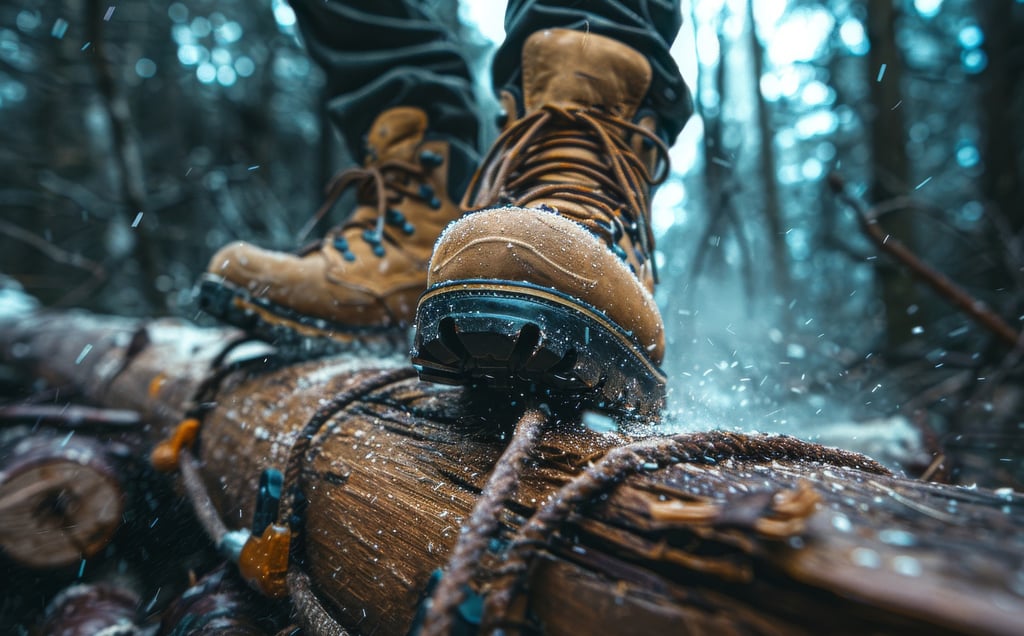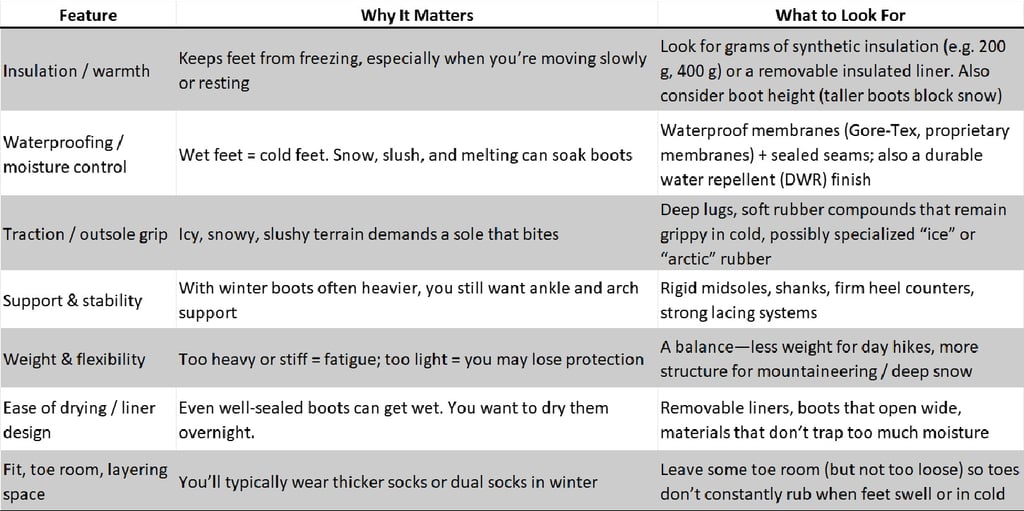The Ultimate Guide to the 10 Best Winter Hiking Boots for Cold-Weather Treks
Stay warm and confident on snowy trails with our guide to the 10 best winter hiking boots for 2025. Discover top-rated waterproof, insulated, and durable boots designed for icy paths, deep snow, and mountain adventures. From lightweight options to extreme cold models, find the perfect pair to keep your feet dry and comfortable all winter long.
10/10/20254 min read


What Makes a Great Winter Hiking Boot?
Before jumping into models, let’s review the key features you should look for when choosing a winter hiking boot. Your ideal pair is the one that balances all or most of these, suited to the the conditions you expect to face.
🔟 Top Picks: Best Winter Hiking Boots for 2025
Below are 10 excellent boots that are frequently recommended by gear reviewers, outdoor testers, and users for cold-weather and snow use. (Order is not strictly ranking, but includes varied uses.)
1. Oboz Bridger Insulated / 10ʺ Bridger
Why it’s good: Frequently highlighted as a top pick for extreme cold hiking. Treeline Review calls it “best winter hiking boot for extreme cold” with strong insulation, good traction, and waterproofing. Treeline Review+1
Specs / features: 200 g / 400 g “Freeze Guard” insulation, B-DRY waterproof membrane, high cut (10ʺ) to block snow, available in wide sizing. Treeline Review+2Section Hiker+2
Trade-offs: Because it’s tall and insulated, it’s relatively heavy, and ankle flexibility / “ground feel” is reduced.
2. KEEN Revel IV Polar / High Polar
Why it’s good: Strong all-around winter hiking boot. SectionHiker includes it in a “10 best” list. Section Hiker Outdoor Gear Lab notes it has good traction in icy conditions. Outdoor Gear Lab
Features: Waterproof, insulated, good traction, stable support.
Things to watch: In deeper snow, its lower shaft may require gaiters. Might feel heavier than lighter hiking boots.
3. The North Face Chilkat V 400
Why it’s good: A solid “snow / winter boot” crossover. It’s frequently listed among serious options in winter hiking boot roundups. Section Hiker+2Outdoor Gear Lab+2
Features: 400 g insulation, mid-to-high shaft, good waterproofing and traction.
Considerations: The insulation is substantial but in very extreme cold (below -20 °C) you may still want something heavier. Also, when dry trails or warmer days come, it might feel bulky.
4. Salewa Puez Winter Mid Powertex
Why it’s good: Backpacker names it “Best Overall” in their winter hiking boot list. Backpacker
Features: A mid-height boot (less tall than mountaineering styles), uses Powertex membrane (Salewa’s proprietary waterproofing) for water resistance, lighter and more nimble.
Trade-offs: Because it’s mid height, it's better suited for snow that isn’t extremely deep or for trail conditions that require better agility over raw insulation.
5. Salomon X Ultra 4 Mid GTX (winter configuration)
Why it’s good: RunRepeat calls it “best winter hiking boot overall,” citing ankle support, traction, and wet conditions performance. #1 Athletic Shoe Review Site
Features: Gore-Tex waterproofing, solid support, relatively light for the performance.
Considerations: Because it’s not a heavy “expedition style” boot, it may underperform in very deep snow or extreme cold unless paired with warm socks or microspikes.
6. Scarpa Moraine Polar GTX
Why it’s good: SectionHiker reviews praise it as a tough winter boot: waterproof Gore-Tex liner, rigid toe box, good traction on rock and snow. Section Hiker
Features: Rugged construction, protection, good for mixed terrain (rock + snow).
Trade-offs: Heavier and more rigid; best when you need durability and structure more than flexibility.
7. Merrell Thermo Chill Mid
Why it’s good: OutdoorGearLab considers it an excellent option for winter hiking (especially in more moderate conditions). Outdoor Gear Lab Switchback also recommends it as a “solid pick” for long winter walks / hikes. Switchback Travel
Features: Waterproof, insulation, lower profile (more nimble), good value.
Limitations: In deep snow, you will likely need gaiters; insulation is moderate, so in very cold / still conditions toes may get cold if you stop moving.
8. La Sportiva Nucleo High II GTX
Why it’s good: Although more of a “wet / snow hybrid” boot, OutdoorGearLab praises its waterproofing and performance in snow / wet environments. Outdoor Gear Lab
Features: Gore-Tex waterproofing, solid build, good for transition seasons and moderate winter conditions.
Notes: It is more of a boot for wet, snowy trails rather than extreme cold. If you expect very low temps, supplement with warm socks.
9. (Bonus) Baffin / Sorel / Muck rugged winter boots (for extreme cold, non-technical / trail use)
While many of the boots above are technical, for extremely cold, static, or severe conditions (e.g. standing, base camp, short hikes), heavy winter boots like Baffin Impact, Sorel Caribou, or Muck Arctic series are often recommended in winter-boot roundups (e.g., OutdoorGearLab) for their top-tier insulation. Outdoor Gear Lab+1 They sacrifice agility and hiking finesse for warmth and toughness.
10. (Honorable) Others mentioned in winter-boot roundups
In lists such as SectionHiker’s “10 best winter hiking boots,” you might find other models like:
Oboz Bridger (already listed)
The North Face Chilkat V 400 (already listed)
Salomon Toundra Pro – for deep snow / stationary use Section Hiker
Others depending on specific brand lineups
If you search around, you may also find winterized versions of classic hiking boots (e.g. mid / full leather boots with added insulation) or boots with removable liners.
🥾 How to Choose Your Best Winter Boot
Here are refinement tips to select among good options above, based on how and where you hike:
Know your typical winter temperature & snow depth
If winters are mild (just a few degrees below freezing, occasional snow), you can lean toward lighter insulated, waterproof hiking boots (e.g. Merrell Thermo Chill, Salewa Puez).
In harsh, sub-zero, or alpine conditions, go with high-insulated, tall boots (Oboz Bridger, Scarpa Moraine Polar) or even “expedition boots.”
Trail type & terrain
Rocky or mixed terrain demands a boot with rigidity & toe protection (Scarpa, La Sportiva).
Deep snow or off-trail use means a taller boot and pair with gaiters.
For icy sections, consider boots compatible with microspikes or crampons.
Weight trade-off
You’ll tire faster with heavier boots. If your hikes are long and you need mobility, favor lighter models even if you lose a bit of insulation.
Fit for winter layering
Try boots while wearing the same socks (or sock system) you use in winter.
Ensure there’s enough room for toe wiggling but not so loose your foot slides.
Drying & maintenance
Boots with removable liners or designs that open wide are easier to dry overnight.
Use proper waterproofing treatments and store them properly between uses.
Traction enhancements
Even great winter boots sometimes need additions. Keep microspikes, crampons, or ice cleats handy.
✅ Final Thoughts & Recommendations
If you want one strong all-around boot for serious winter hiking, the Oboz Bridger (especially the 10ʺ insulated version) is a standout for its warmth, traction, and proven performance in extreme cold.
For lighter winter hiking or transitional seasons, the Merrell Thermo Chill or Salewa Puez Winter Mid offer great versatility.
If you hike in rocky, mixed terrain with snow, boots like the Scarpa Moraine Polar GTX or La Sportiva Nucleo High II GTX might be ideal.
For static, basecamp, or deep cold conditions, heavier insulated winter boots (Baffin, Sorel, etc.) are worth considering as a supplement.


Contact us
Copyright © 2025. Ralnoscape All rights reserved.
Destinations
Resources


Follow us
This website uses affiliate links which may earn a commission at no additional cost to you
